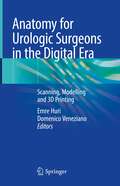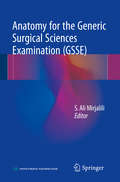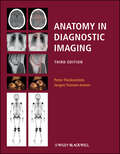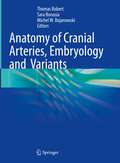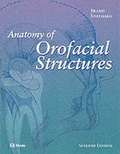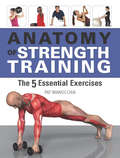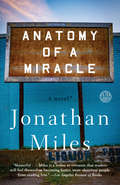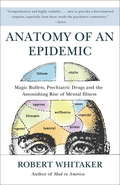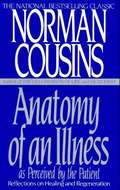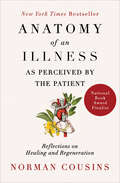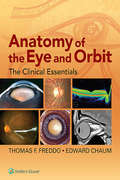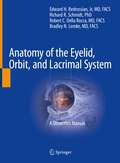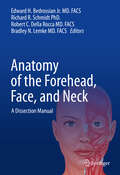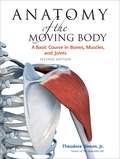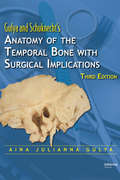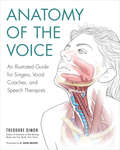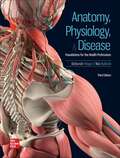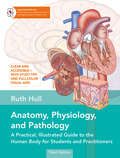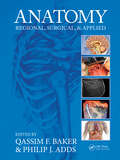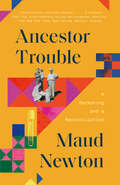- Table View
- List View
Anatomy for Urologic Surgeons in the Digital Era: Scanning, Modelling and 3D Printing
by Emre Huri Domenico VenezianoThis book provides a practical guide in the use of imaging and visualization technologies in urology. It details how output from diagnostic systems, can be represented through synthetic, virtual and augmented reality tools, such as holograms and three dimensional (3D) modelling and how they can improve everyday surgical procedures including laparoscopic, robotic-assisted, open, endoscopic along with the latest and most innovative approaches. Anatomy for Urologic Surgeons in the Digital Era: Scanning, Modelling and 3D Printing systematically reviews diagnostic imaging, visualization tools available in urology and is a valuable resource for all practicing and in-training urological surgeons.
Anatomy for the FRCA
by James Bowness Alasdair TaylorAnatomy questions are asked in all parts of the FRCA examinations, and for many trainees it is a particularly daunting part of the exams. This important new book provides a comprehensive, exam-orientated clinical anatomy book for anaesthetists preparing for all parts of the FRCA. It covers all body regions, relating underlying anatomy to practical procedures and anatomical principles, spanning the breadth of the curriculum and comprising exam-style questions: a chapter of SAQ questions, one of OSCE stations, one of SOE questions and one of MCQs. The text is highly illustrated in full colour with ultrasound images, diagrams and photographs of cadaveric material and models. This is the first anatomy book specifically orientated for the FRCA exam, making it an essential resource for anaesthetists preparing for all parts of the FRCA examination.
Anatomy for the Generic Surgical Sciences Examination (GSSE)
by S. Ali MirjaliliThis book is designed for Generic Surgical Sciences Examination (GSSE). This collection of questions and answers as well as short notes is intended to assist junior doctors in successfully sitting the GSSE. The questions are specifically designed to highlight key surgical anatomy, and are supplemented by images that replicate "spot-test" type questions. Illustrations are used here to highlight particular anatomical relationships that are difficult to grasp. Beyond the GSSE, this resource will be invaluable for those undertaking study for specialty-specific anatomy examinations, or the anatomy component of the fellowship examination. <P><P> This is a "prep course" specifically designed for passing the Generic Surgical Science Examination required by the Royal Australasian College of Surgeons (RACS).
Anatomy in Action: The Dynamic Muscular Systems that Create and Sustain the Moving Body
by Theodore DimonAn illustrated guide to the core design principles of the body&’s musculoskeletal system—for kinesiologists, movement therapists, yoga teachers, dancers, and bodyworkers of all kindsWhat does knowledge of anatomical structure have to do with preventing everyday muscular aches, pains, and injuries? According to Dr. Theodore Dimon, everything!Our bodies are designed to work holistically, supported by an intelligently organized system of muscles, bones, and connective tissue. So when we target problem spots by stretching, relaxing, or strengthening individual muscles, we bypass the dynamic, interconnected network that enables healthy functioning and injury prevention. Understanding how this system works in action is the key.In this groundbreaking guide, Dr. Dimon describes the basic principles that govern our bodies&’ musculoskeletal architecture and provides practical exercises to activate specific muscle groups and demonstrate our bodies&’ efficient holistic function. Readers will learn about dynamic design and the body in action, including: • How the musculoskeletal system works as a whole • The relationship between proprioception and muscle length • About maximizing spinal, shoulder, hip, arm, and leg stability and health • The important role of breath and breathing • About posture and musculoskeletal support With more than 300 illustrations, this is an ideal resource for students and practitioners of kinesiology, bodywork, movement, sport kinesiology, dance, and all readers searching for a dynamic guide to the human body.
Anatomy in Diagnostic Imaging
by J?rgen Tranum-Jensen Peter FleckensteinNow in its third edition, Anatomy in Diagnostic Imaging is an unrivalled atlas of anatomy applied to diagnostic imaging. The book covers the entire human body and employs all the imaging modalities used in clinical practice; x-ray, CT, MR, PET, ultrasound and scintigraphy. An introductory chapter explains succinctly the essentials of the imaging and examination techniques drawing on the latest technical developments.In view of the great strides that have been made in this area recently, all chapters have been thoroughly revised in this third edition. The book's original and didactically convincing presentation has been enhanced with over 250 new images. There are now more than 900 images, all carefully selected in order to be user-friendly and easy-to-read, due to their high quality and the comprehensive anatomical interpretation directly placed alongside every one.Both for medical students and practising doctors, Anatomy in Diagnostic Imaging, Third edition will serve as the go-to all-round reference collection linking anatomy and modern diagnostic imaging.
Anatomy of Cranial Arteries, Embryology and Variants
by Thomas Robert Sara Bonasia Michel W. BojanowskiThis book on the anatomy of central nervous system arteries concentrates on all anatomical variations of the central nervous system and it describes the embryological processes that hide behind the possible adult variants.The first section of the work is a reminder of general concepts of embryology. After that, each section corresponds to arteries of an anatomical location: intradural, dural, skull base and cranio-cervical junction. Each chapter is dedicated to a single artery to facilitate the reader’s search for information. In addition, modern and detailed illustrations of the embryological steps and adult variants are included. There are two types of illustrations: artist’s drawing, usually to explain the vascular embryology, and angiographic images. The central point of the book lies in the space devoted to the embryological development of each artery and the processes that can lead to the development of different variants in the adult. The audience of this book is aimed at neurosurgeons and neuroradiologists, specialists in the neurovascular area, but it will also help residents in neurosurgery, neuroradiology and neurology in their daily practice.
Anatomy of Medical School Admissions: Need-to-Know Information about Getting into Med School, the MCAT, and What it Takes to Be a Doctor (Graduate School Admissions Guides)
by Princeton ReviewThe Princeton Review Knows Med School. Thinking about a career in medicine? This is the book you need to ensure you're prepared in every way: Learn about medical school admissions, career options, how to prepare yourself as an undergrad, and, of course, about the major changes coming to the MCAT in 2015. The health system of tomorrow will require a different kind of physician. With over 30 years of experience and a proven track record helping millions of students achieve their goals, The Princeton Review is the only company with the expertise and resources to guide you through each step of your journey. We're not just about test prep: we're about prepping for your life. Inside this eBook, you'll find guidance and advice on topics like:* Do You Have What it Takes? (Thinking Like a Medical Student)* Is a Career in Medicine Right For You? (What They Don't Tell You at Career Day)* Everything You Need to Know about Med School Admissions* Researching Medical Schools, or ... Making the List* Q&A With Admissions Officers* The Inside Scoop on Applications, Personal Statements, Financial Aid, and More ...* How to Rock the Interview* The MCAT: Now and 2015* Preparing for and Taking the MCAT* Sample Personal Statements
Anatomy of Orofacial Structures (Seventh Edition)
by Richard W. Brand Donald E. IsselhardThis comprehensive edition on orofacial structures provides a complete introduction with dedicated sections on dental anatomy,oral histology and embryology, head and neck anatomy.
Anatomy of Strength Training
by Pat ManocchiaWorking out can be fun and rewarding. But if you're not doing it correctly, it can seem pointless, and even painful. Knowing the best way to build muscle-and knowing why it's the best way-can mean the difference between a lifelong devotion to exercise and a fabulously fit body, or giving up in frustration.Health and fitness expert Pat Manocchia gives readers the tools they need to embark on a journey of fitness and health, from basic movements to information on how to build a complete exercise plan. With step-by-step instructions and easy-to-follow illustrations of starting positions and movement paths, it's like having your very own personal trainer.Learn what to do and what not to do. For example, hands should be shoulder-width apart during a chin-up, and you should never, ever swing the body during that move. Keep a slight arch in the back while performing a dead lift, and do so by keeping the head up. Find out how to get results by following these and other exercises.Anatomy of Strength Training brings a new dimension to workouts, helping readers target every problem area-and helping them stay on the path to health and fitness.
Anatomy of a Miracle: A Novel*
by Jonathan Miles“A remarkable combination of medical mystery, satire and war story. Like Ben Fountain's Billy Lynn's Long Halftime Walk, it captures the long-lasting effects of war by focusing on those for whom war is only a tangential thing somewhere far away.” — Shelf Awareness"Miles's powerful prose nudges readers to seek the soft spots between faith and judgement, story and science, and fact and fiction." — CJ Lotz, Garden & GunA profound new novel about a paralyzed young man’s unexplainable recovery—a stunning exploration of faith, science, mystery, and the meaning of life Rendered paraplegic after a traumatic event four years ago, Cameron Harris has been living his new existence alongside his sister, Tanya, in their battered Biloxi, Mississippi neighborhood where only half the houses made it through Katrina. One stiflingly hot August afternoon, as Cameron sits waiting for Tanya during their daily run to the Biz-E-Bee convenience store, he suddenly and inexplicably rises up and out of his wheelchair. In the aftermath of this “miracle,” Cameron finds himself a celebrity at the center of a contentious debate about what’s taken place. And when scientists, journalists, and a Vatican investigator start digging, Cameron’s deepest secrets—the key to his injury, to his identity, and, in some eyes, to the nature of his recovery—become increasingly endangered. Was Cameron’s recovery a genuine miracle, or a medical breakthrough? And, finding himself transformed into a symbol, how can he hope to retain his humanity? Brilliantly written as closely observed journalistic reportage and filtered through a wide lens that encompasses the vibrant characters affected by Cameron’s story, Anatomy of a Miracle will be read, championed, and celebrated as a powerful story of our time, and the work of a true literary master.
Anatomy of an Epidemic: Magic Bullets, Psychiatric Drugs, and the Astonishing Rise of Mental Illness in America
by Robert WhitakerIn this astonishing and startling book, award-winning science and history writer Robert Whitaker investigates a medical mystery: Why has the number of disabled mentally ill in the United States tripled over the past two decades? Every day, 1,100 adults and children are added to the government disability rolls because they have become newly disabled by mental illness, with this epidemic spreading most rapidly among our nation’s children. What is going on?<P><P> Anatomy of an Epidemic challenges readers to think through that question themselves. First, Whitaker investigates what is known today about the biological causes of mental disorders. Do psychiatric medications fix “chemical imbalances” in the brain, or do they, in fact, create them? Researchers spent decades studying that question, and by the late 1980s, they had their answer. Readers will be startled—and dismayed—to discover what was reported in the scientific journals.<P> Then comes the scientific query at the heart of this book: During the past fifty years, when investigators looked at how psychiatric drugs affected long-term outcomes, what did they find? Did they discover that the drugs help people stay well? Function better? Enjoy good physical health? Or did they find that these medications, for some paradoxical reason, increase the likelihood that people will become chronically ill, less able to function well, more prone to physical illness? <P> This is the first book to look at the merits of psychiatric medications through the prism of long-term results. Are long-term recovery rates higher for medicated or unmedicated schizophrenia patients? Does taking an antidepressant decrease or increase the risk that a depressed person will become disabled by the disorder? Do bipolar patients fare better today than they did forty years ago, or much worse? When the National Institute of Mental Health (NIMH) studied the long-term outcomes of children with ADHD, did they determine that stimulants provide any benefit? <P> By the end of this review of the outcomes literature, readers are certain to have a haunting question of their own: Why have the results from these long-term studies—all of which point to the same startling conclusion—been kept from the public? <P> In this compelling history, Whitaker also tells the personal stories of children and adults swept up in this epidemic. Finally, he reports on innovative programs of psychiatric care in Europe and the United States that are producing good long-term outcomes. Our nation has been hit by an epidemic of disabling mental illness, and yet, as Anatomy of an Epidemic reveals, the medical blueprints for curbing that epidemic have already been drawn up.
Anatomy of an Illness as Perceived by the Patient: Reflections on Healing and Regeneration
by Norman CousinsAnatomy of an Illness is the story of Norman Cousins and his successful fight against a crippling disease. It is the story of a partnership between a physician and a patient in beating back the odds. The doctor's genius lay in helping the patient use his own powers -- laughter, courage and tenacity. The patient's talent was in mobilizing his body's own natural healing resources -- in proving what powerful weapons all the positive emotions can be in the war against disease.
Anatomy of an Illness as Perceived by the Patient: Reflections on Healing and Regeneration
by Norman CousinsNational Book Award Finalist: The &“amazing&” New York Times bestseller about the power of laughter and optimism in fighting serious illness (Chicago Sun-Times). Norman Cousins&’s iconic firsthand account of victory against terminal disease, Anatomy of an Illness as Perceived by the Patient inspired a revolution, encouraging patients to take charge of their own treatment. A political journalist and activist, Cousins was also a professor of medical humanities at UCLA, where he studied the biochemistry of human emotions and their relationship to healing. When Cousins was hospitalized with a debilitating collagen illness, he decided to take his health into his own hands. Cousins and his doctor combated the disease together by creating a regimen of laughter and vitamin C specifically calibrated to his needs. Against all odds, the treatment worked, proving to Cousins that a positive attitude was key to his improvement. Years later, Cousins set pen to paper to tell the story of his recovery. In this humorous and insightful account, Cousins analyzes his own journey in relation to holistic medicine and discusses the astounding power of mind over body. The result is an inspirational and educational guide to health that continues to offer hope to many. This ebook features an extended biography of Norman Cousins by his daughter, Sarah Cousins Shapiro.
Anatomy of the Eye and Orbit: The Clinical Essentials
by Thomas F. Freddo Edward ChaumMaster the Clinical Essentials of ocular and orbital anatomy for clinical practice! The eye is an organ of great complexity. Anatomy of the Eye and Orbit: The Clinical Essentials achieves the impressive task of presenting all the ocular anatomy that ophthalmology residents, optometry residents, and optometry students need to know – in a single accessible, high-yield volume. It emphasizes the aspects of eye and orbit anatomy that are most relevant to clinicians in training, providing the practical, real-world foundation necessary for practice.
Anatomy of the Eyelid, Orbit, and Lacrimal System: A Dissection Manual
by Edward H. Bedrossian Richard R. Schmidt Robert C. Della Rocca Bradley N. LemkeThis book is a dissection manual and atlas on the anatomy of the eyelid, orbit, and lacrimal system; it functions as a succinct yet comprehensive resource. Opening chapters provide an introduction to the topic and outline instruments needed for the dissections. Subsequent chapters then describe the dissection of the eyelid in various layered approaches. Then, further discussions demonstrate the neuroanatomy of the cranial fossae, the cavernous sinus, and the dissection of deep orbital structures from an anterior, superior and lateral approach. Closing chapters then examine the nasolacrimal system and nasal cavities Anatomy of the Eyelid, Orbit, and Lacrimal System is an expertly written invaluable resource for the surgeon seeking to enhance their knowledge and surgical skills.
Anatomy of the Forehead, Face, and Neck: A Dissection Manual
by Richard R. Schmidt Robert C. Della Rocca Bradley N. Lemke Edward H. Bedrossian Jr.Like its companion volume, Anatomy of the Eyelid, Orbit, and Lacrimal System: A Dissection Manual, this unique dissection manual provides a detailed step-by-step approach to the dissection of the forehead, face, and neck, in a structural, layered approach. This dissection manual follows an atlas format, with color photographs from past professional lectures and classroom courses, as well as line drawings, enhancing descriptions. Clinical correlations are also interjected throughout to highlight the importance of individual anatomic structures. Chapters describe the preparation and storage of specimens and the dissection of the forehead and eyebrows, the midface, nose, ear, and lower face, and the neck. Anatomy of the Forehead, Face, and Neck: A Dissection Manual is an expertly written, invaluable resource for surgeons seeking to enhance their knowledge and surgical skills.
Anatomy of the Moving Body, Second Edition: A Basic Course in Bones, Muscles, and Joints
by Theodore Dimon John QualterLearning anatomy requires more than pictures and labels; it requires a way "into" the subject, a means of making sense of what is being shown. Anatomy of the Moving Body addresses that need with a simple yet complete study of the body's complex system of bones, muscles, and joints and how they function. Beautifully illustrated with more than 100 3D images, the book contains 31 lectures that guide readers through this challenging interior landscape. Each part of the body is explained in brief, manageable sections, with components described singly or in small groups. The author doesn't just name the muscles and bones but explains the terminology in lay language. Topics include the etymology of anatomical terms; origins and attachments of muscles and their related actions; discussion of major functional systems such as the pelvis, ankle, shoulder girdle, and hand; major landmarks and human topography; and structures relating to breathing and vocalization. This second edition features all-new illustrations that use a 3D digital model of the human anatomical form. The book's thoroughness, visual interest, and clear style make it ideal for students and teachers of the Alexander and Feldenkrais techniques as well as for practitioners of yoga, Pilates, martial arts, and dance.
Anatomy of the Temporal Bone with Surgical Implications
by Aina Julianna GulyaDetailed knowledge of the complex microanatomy of the temporal bone is essential for surgeons executing invasive therapeutic procedures. Based on the human temporal bone collection at the Massachusetts Eye and Ear Infirmary, this lavishly illustrated Third Edition includes a DVD offering 159 full-color photomicrographs and side-by-side 3-D stereo i
Anatomy of the Voice: An Illustrated Guide for Singers, Vocal Coaches, and Speech Therapists
by Theodore Dimon G. David BrownThe first comprehensive, fully-illustrated approach to the voice that explains the anatomy and mechanics in detailed yet down-to-earth terms, for voice users and professionals of all kindsThis book is the first to explain, in clear and concise language, the anatomy and mechanics of the mysterious and complex bodily system we call the voice. Beautifully illustrated with more than 100 detailed images, Anatomy of the Voice guides voice teachers and students, vocal coaches, professional singers and actors, and anyone interested in the voice through the complex landscape of breathing, larynx, throat, face, and jaw. Theodore Dimon, an internationally recognized authority on the subject, as well as an expert in the Alexander Technique, makes unfamiliar terrain accessible and digestible by describing each vocal system in short, manageable sections and explaining complex terminology. The topics he covers include ribs, diaphragm, and muscles of breathing; the intrinsic musculature of the larynx, its structure and action; the suspensory muscles of the throat; the face and jaw; the tongue and palate; and the evolution and function of the larynx.
Anatomy, Physiology And Disease: Foundations For The Health Professions
by Deborah Roiger Nia Joyner BullockIn Roiger/Bullock, connections are made between systems so that students learn how the body functions normally in homeostasis, and how disruption of homeostasis leads to disease and disorder. With a straightforward writing style that engages the reader directly, the authors explain difficult concepts in the context of daily activities, making them easier to grasp. A one-column design and brand new art program also makes the content more inviting and facilitates comprehension in students. Chapters are mapped out by specific learning outcomes so that there are no surprises, and all exercises throughout the text, workbook, and digital ancillaries are directly tied to these measurable outcomes. Integrated digital content includes Body ANIMAT3D and audio pronunciations. Roiger and Bullock’s text requires no prior knowledge of chemistry or cell biology, and is designed for a one-semester, entry-level A&P course.
Anatomy, Physiology, and Disease: Foundations for the Health Professions
by Deborah Roiger Nia BullockRoiger and Bullock’s unique pedagogical and visual approach helps students make the important connections between systems and learn how the body functions normally in homeostasis, and how disruption of homeostasis leads to disease and disorder. With a straightforward, engaging writing style, the authors explain difficult concepts in the context of routine activities, making concepts easier to grasp. Measurable learning outcomes throughout the textbook, workbook, and digital learning and assessment program help direct students through the content so there are no surprises. Anatomy, Physiology, Disease requires no prior knowledge of chemistry or cell biology, and is designed for an anatomy and physiology course or an anatomy, physiology, and pathology course. It is neither too high nor too low and can be customized to accommodate the organization of individual courses.
Anatomy, Physiology, and Pathology, Third Edition: A Practical, Illustrated Guide to the Human Body for Students and Practitioners--Clear and accessible, with study tips and full-color visual aids
by Ruth HullA full-color, easy-to-understand introduction to anatomy, physiology, and pathology that's designed to provide a comprehensive understanding of the human body without overwhelming readers.Anatomy, Physiology, and Pathology is the ideal introduction on the topic for students of complementary and physical therapies. Designed for ease of learning both as an independent study resource and in the classroom, this textbook is suitable for anyone requiring detailed knowledge of these subjects and has been adopted by colleges worldwide.Author and therapist Ruth Hull provides a thorough understanding of anatomy, physiology, and pathology with clear, accessible language and helpful learning tools. It&’s designed for easy comprehension, with more than 300 clearly labeled color images; flow charts, diagrams, and tables to help visualize complex ideas; study tips; practice questions in each chapter; and more.Chapters outline the following systems:Skin, hair, and nailsSkeletal, muscular, and nervous systemsEndocrine and respiratory systemsCardiovascular, lymphatic, and immune systemsDigestive systemUrinary systemReproductive systemThis book also serves as an effective refresher for current healthcare and bodywork professionals.
Anatomy--Head and Neck: A Pocket Book for the Clinician
by Andrew ZbarThis book offers an easy-to-follow technique to better appreciate the anatomy of the head and neck providing a concise, accessible and well-illustrated pocketbook. It is aimed principally at undergraduate and postgraduate students of anatomy in a wide range of fields such as medicine, dentistry and the paramedical services that include physiotherapy, occupational therapy and the biological sciences. The book should prove useful for postgraduate trainees in general and specialist surgery, radiology and interventional and emergency medicine. Providing a style of teaching that is grounded in a clinical context, the book explains why the anatomy that has been learned actually matters. Relevant developmental and comparative anatomy is incorporated placing the subject in an historical context. The book is footnoted and includes pertinent references and multichoice questions at the end of each chapter. The anatomy conveyed is presented with simple line drawings designed to answer specific anatomical questions. Students are encouraged to reproduce these images with the view that if they can draw the anatomy of a region they will understand and remember it well. This book changes the way anatomy is taught using a short, practical guide to cover specific body regions.
Anatomy: Regional, Surgical, and Applied
by Qassim F. Baker Philip J. AddsAn easy-to-read book written by students for students, edited by senior clinicians and anatomy academics, with contributions from leading anatomists and clinicians. Anatomical facts are correlated with clinical settings, especially medical emergencies, and important points are highlighted with clear learning points. The text is supplemented by diagrams and images, which form an essential part of this book. It covers the students’ learning objectives in undergraduate anatomy curricula and helps in preparing them for practical and written exams. It forms a solid foundation for future clinical exams based on the knowledge of anatomical facts in a clinical setting. Key Features• Presents a concise, accessible guide to regional and clinically applied anatomy, which clearly demonstrates to students the level of knowledge required for medical and healthcare-related curricula• Uses high-quality clinical and intraoperative images integrated into the text to emphasizes important topics through bullet points• Features logically arranged sections, each devoted to a body region or system, which includes a self-test quiz, with the single best answer and spotter-style questions
Ancestor Trouble: A Reckoning and a Reconciliation
by Maud NewtonONE OF THE MOST ANTICIPATED BOOKS OF 2022—Oprah Daily, Time, Esquire, The Millions, The Week, Thrillist, She Reads, Lit Hub, BookPage. <p><p> Maud Newton’s ancestors have vexed and fascinated her since she was a girl. Her mother’s father, who came of age in Texas during the Great Depression, was said to have married thirteen times and been shot by one of his wives. Her mother’s grandfather killed a man with a hay hook and died in an institution. <p><p> Mental illness and religious fanaticism percolated through Maud’s maternal lines back to an ancestor accused of being a witch in Puritan-era Massachusetts. Maud’s father, an aerospace engineer turned lawyer, was an educated man who extolled the virtues of slavery and obsessed over the “purity” of his family bloodline, which he traced back to the Revolutionary War. He tried in vain to control Maud’s mother, a whirlwind of charisma and passion given to feverish projects: thirty rescue cats, and a church in the family’s living room where she performed exorcisms. <p><p> Her parents’ divorce, when it came, was a relief. Still, her position at the intersection of her family bloodlines inspired in Newton inspired an anxiety that she could not shake, a fear that she would replicate their damage. She saw similar anxieties in the lives of friends, in the works of writers and artists she admired. As obsessive in her own way as her parents, Newton researched her genealogy—her grandfather’s marriages, the accused witch, her ancestors’ roles in slavery and genocide—and sought family secrets through her DNA. But immersed in census archives and cousin matches, she yearned for deeper truths. Her journey took her into the realms of genetics, epigenetics, and the debates over intergenerational trauma. She mulled over modernity’s dismissal of ancestors along with psychoanalytic and spiritual traditions that center them.
